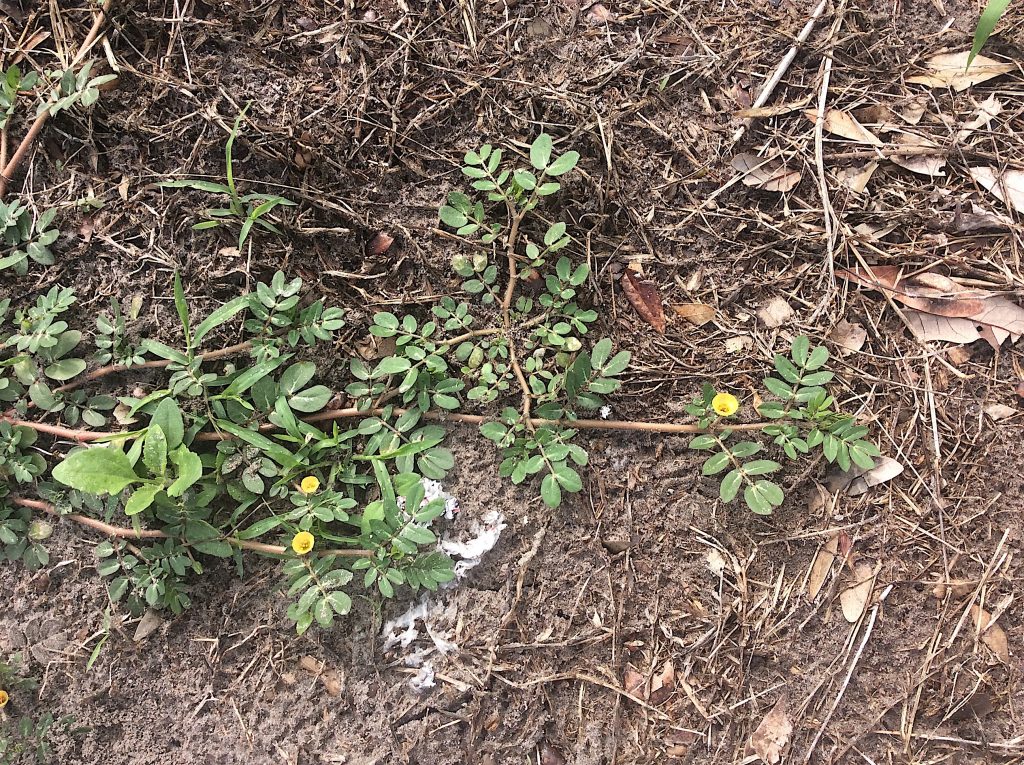
At first glance Big Calrop can resemble purslane. Photo by Green Deane
If you’re an adult with aging eyesight Kallstroemia maxima when first spied can look like purslane. A closer examination shows it is not. But they do bear some resemblance. While purslane is a prime wild edible (and also a commercial crop) K. maxima, aka Big Caltrop, is a famine food, or an acquired taste, whichever comes first.
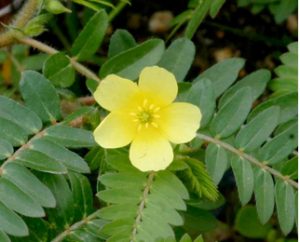
Tribulus terrestris is a close relative and marginally edible, too
According to the botanical Gods there are 17 species of Kallstroemia, two local, K. maxima and K. pubescens. They are the next-to-last entry in Guide to the Vascular Plants of Florida by Wunderlin and Hansen. After Kallstroemia is the genus Tribulus. T. terrestris, so-called Puncture Vine, is a questionable weight-lifting supplement. It has been implicated in gonad shrinkage. The usual explanation is T. terrestris — which is also marginally edible — provides testosterone thus the gonads do not need to make it naturally so they give up the ghost so to say and shrink… permanently. K. maxima has the basic birth control pill hormone diosgenin. As Kallstroemia and Tribulus are closely related I would not make it a habit to eat or use either a lot whether male or female.
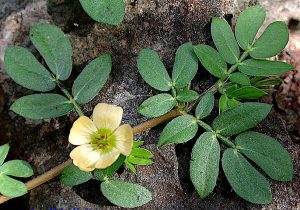
Big Caltrop leaves are bipinnate.
Daniel Austin, in his book Florida Ethnobotnany, managed to craft one full page on the species. We know it’s in the Zygophyllaceae Family which includes Lignumvitae. K. maxima is the most wide-spread in Florida with K. pubescens listed as rare and only in Franklin County though it is more common in tropical area. We also know people in El Salvado and Colombia occasionally cook the young leaves of K. maxima for famine food. Medicinally the species has had many applications. It is a diuretic and a laxative. Crushed leaves have been put on boils and other sores. In Cuba concoctions are used to treat skin problems and as a decoction or a tincture for urticaria. In Venezuela it is used to treat abscesses and tumors. The species is also known to sicken domestic animals and is very toxic to sheep. However, it seeds are an important food for dove and quail.
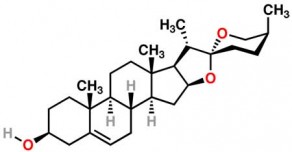
Diosgenin
As an aside I question the fogginess of several references regarding plant hormones. I was not allowed to take chemistry but it would seem T. terrestris, which can stimulate testosterone production, is different than K. maxima which has diosgenin. That hormone was originally isolated in yams and used to make birth control pills. More to the point calling K. maxima “green viagra” as some writers do, would seem to be heading in the wrong direction with the wrong sex. The entire plant has been reported as a contraceptive for women. That’s quite chemical difference than being an analogue molecule for or stimulant for testosterone. Diosgenin can through several processes end up as testosterone but it can also end up estrogen. Big Caltrop and Puncture Vine might be all right as a food now and then but uses beyond that — such as dried and as a supplement or tea — should come under close chemical scrutiny.

400-year old Caltrops
The genus is named for A. (Andrew?) Kallstroem who was a friend of the botanist Giovanni Antonio Scopoli for whom the genus Scopolia and the drug scopolamine are named. The name Kallstroem itself means “Spring River.” The common name, Caltrop, has a rich if not bloody history. It is a jack with three or four spikes that comes to rest with some spikes up. At least a thousand years ago it was thrown in front of advancing cavalry. “Caltrop” comes from calatrippe from the Latin calci —spur or heel – and trappa meaning trap… Or heel trap. And in Dead Latin the Romans called Caltrops… Tribulus which means “jagged iron.”
Green Deane Itemize Plant Profile
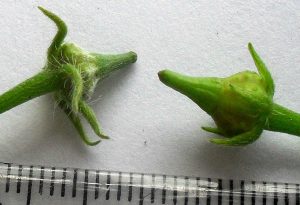
K. pubescens, left, has hairy seeds, K. maxima, right, does not.
IDENTIFICATION: Prostrate herb with ascending stem tips; leaves opposite, once-pinnately compound, even-pinnate; leaflet shape variable in detail, but generally oblong-elliptic with acute ends and asymmetric bases, especially so on the terminal leaflets; flowers axillary; petals yellow or pale orange; fruits spiny. Terminal leaves are usually cloven like a cow’s foot. The seeds of K. maxima are not hairy, the seeds of K. pubescens are. One give-away for me are the blossoms that form a chalice shape before opening fully.
TIME OF YEAR: It grows and blossom all year except in the most northern regions where mild winter interferes.
ENVIRONMENT: Open, disturbed habitats. That said I have seen it damp places that dry occasionally to dry spots that are only watered by rain.
METHOD OF PREPARATION: Young leaves boiled.


As a swede I had to check who Kallström (Swedish spelling) was. I could not find a lot of information. Anders Kallström (1733-1812) is mentioned in several places (e.g. https://www.swcoloradowildflowers.com/Yellow%20Enlarged%20Photo%20Pages/kallstroemia%20and%20tribulus.htm). There seems to be no Wikipedia entry for him.
The etymology giving the translation “spring river” for the name Kallström is by the way wrong. Kallström is a combination of cold (kall) and current or possibly rapids (both “ström” in Swedish). There are also a few rivers with “ström” in the name, so river is not a totally wrong translation but a less common meaning of “ström” at least today. A (water) spring is “källa”, an easy mistake as “ä” does not exist in the English alphabet and Källström is a more common name than Kallström in Sweden.